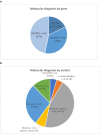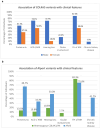Detection of Alport gene variants in children and young people with persistent haematuria
- PMID: 39349776
- PMCID: PMC11746956
- DOI: 10.1007/s00467-024-06538-8
Detection of Alport gene variants in children and young people with persistent haematuria
Abstract
Background: Genetic kidney disease is an important cause of persistent microscopic haematuria in children and young people. We aimed to determine the frequency of variants in the Alport syndrome genes (COL4A3, COL4A4 or COL4A5) in individuals under 18 years of age presenting with persistent microscopic haematuria to a single specialist centre in the UK over a 10-year period.
Methods: We conducted a retrospective longitudinal study of individuals referred to a tertiary paediatric nephrology service with persistent microscopic haematuria between April 2012 to 2022.
Results: A total of 224 individuals (female 51.8%) were evaluated with persistent microscopic haematuria of greater than 6 months duration. The age at presentation was 7.5 ± 4.3 years (mean ± SD) with a duration of follow-up of 6.8 ± 4.6 years (mean ± SD). Targeted exome sequencing was performed in 134 individuals and 91 (68%) had a pathogenic or likely pathogenic variant in COL4A3, COL4A4 or COL4A5. Only 49.5% of individuals with identified variants had a family history of microscopic haematuria documented and 37.4% (34/91) had additional proteinuria at presentation. COL4A5 was the most common gene affected and missense variants affecting glycine residues were the most common variant type.
Conclusion: Over two-thirds of children and young people who underwent genetic testing had an identifiable genetic basis for their microscopic haematuria and over half did not have a documented family history. Genetic testing should be part of the evaluation of persistent microscopic haematuria despite a negative family history.
Keywords: Genetic kidney disease; Genetic testing; Microscopic haematuria.
© 2024. The Author(s).
Conflict of interest statement
Declarations. Competing interests: The authors declare no competing interests. Preprint disclosure: This manuscript has been posted on a preprint server at the following link: https://urldefense.com/v3/__https://www.researchsquare.com/article/rs-3539103/__;!!PDiH4ENfjr2_Jw!H89HwZWGRCKHjZEqPrTAWhq8mVrhHFSPnVLxeFpMeyLtnyByZYbpwa9n6ULAwO4xpzHG6_9-Na9gsdHfE1mi8S0BlQ$
Figures




References
-
- Lunn A, Forbes TA (2012) Haematuria and proteinuria in childhood. Paediatr Child Health 22:315–321
-
- Clark M, Aronoff S, Del Vecchio M (2015) Etiologies of asymptomatic microscopic hematuria in children-systematic review of 1092 subjects. Diagnosis (Berl) 2:211–216 - PubMed
-
- Moreno JA, Yuste C, Gutiérrez E, Sevillano ÁM, Rubio-Navarro A, Amaro-Villalobos JM, Praga M, Egido J (2016) Haematuria as a risk factor for chronic kidney disease progression in glomerular diseases: a review. Pediatr Nephrol 31:523–533 - PubMed
-
- Vivante A, Afek A, Frenkel-Nir Y, Tzur D, Farfel A, Golan E, Chaiter Y, Shohat T, Skorecki K, Calderon-Margalit R (2011) Persistent asymptomatic isolated microscopic hematuria in Israeli adolescents and young adults and risk for end-stage renal disease. JAMA 306:729–736 - PubMed
-
- Feld LG, Meyers KEC, Kaplan BS, Stapleton FB (1998) Limited evaluation of microscopic hematuria in pediatrics. Pediatrics 102:e42–e42 - PubMed
MeSH terms
Substances
Grants and funding
LinkOut - more resources
Full Text Sources
Miscellaneous

